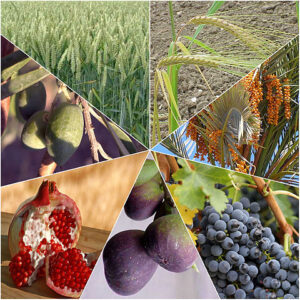Many people argue that there is no such thing as Israeli cuisine. I find that argument ridiculous, and driven by ulterior motives, rather than a desire to actually uncover truth. Every country has its own cuisine (or cuisines), and Israel is of course no different. When I give my food talk “A Land of Milk and Mufletta: At the Crossroads of Israel’s Cuisine and Culture,” I start with a brief statement about the different elements that define Israel’s gastronomic culture. Briefly, here, I want to translate them into five iconic metaphors — images that each explain an element of Israeli cuisine, and that combine to make this country’s foodways unique.
Bullseye

Thus, a bullseye target is the first metaphor. What is usable for food in Israel is the center, and as you move further away, things change more and more. In ancient times, we know some of the primary foods via both archaeology and the Jewish Bible. We can identify some of the animals which were able to be slaughtered and consumed. We know of the Seven Species, all of which were popular here in the past, and are still popular today: wheat, barley, olives, grapes, pomegranates, figs, and dates. We also read of the Mediterranean Triad: grain, olive oil, and wine. Then, as the centuries progressed, more and more foods got added to the local pantry.
Venn Diagram
Moving beyond the available ingredients, the dishes we consume in Israel are drawn from a regional cuisine. But, of course, all countries are part of larger regions. What sets Israel apart is that we sit at the meeting point of two separate regions, the Middle East and the Mediterranean. Israel sits along the western edge of the Middle East, and the eastern shores of the Mediterranean. Hence the Venn diagram, with Israel occupying the central slice of overlap.
People think largely of Middle Eastern foods when they think of Israeli cuisine — dishes such as falafel, hummus, pita, etc. But many other elements of our cuisine reach westward rather than eastward. That trio of grain, olive oil, and wine should be familiar, for example, to any lover of Spanish cuisine, and would be fairly foreign to fans of Iraqi food. And not just because Muslims don’t drink alcohol. Even table grapes are not a major part of Middle Eastern cuisine.
Israel’s cuisine draws on elements from the two regions it straddles, blending them together in one location.
Fingerprints

The Ottoman Turks ruled here for 400 years; today in Israel we love the descendents of Turkish food, such as bourekas and shwarma, and we use a Turkish word (mangal) to describe a charcoal grill. With the growth of Zionism, we saw kibbutz galuyot, the ingathering of the exiles, with Jewish immigrants returning to Israel from all over the world. They brought their foods with them, so we have empanadas alongside sabich alongside couscous alongside Buffalo wings, and much more. The more ancient cultures’ fingerprints have faded more, but can still be found when we dig down, uncovering how ingredients or dishes were brought here from other lands.
Scroll
In addition to different nationalities that have ruled or sent immigrants here, the different religions (symbolized by the ancient medium of scripture, a scroll) have also affected Israeli cuisine. Nowadays, Jews are by far the numerically dominant culture in Israel. So while not all Jews here are religiously observant, laws of kashrut still play a large role in Israeli cuisine. For example, many baked goods that might otherwise be made with butter or milk, here will be made with oil or margarine so they can be consumed with a meat meal by those who religiously separate milk and meat products.
Historically, as noted above, Israel was a wine producing region. But by the late 1800s, there was almost no wine production in the land. This was due to 600 years of Muslim rule after the Crusades. Since Muslims do not consume alcohol, production even by Christians or Jews was highly limited and the small market size meant large scale production would not be feasible anyway.
And since both Muslims and Jews religiously avoid pork, pig products were never a major element in Israel’s cuisine (though it has become somewhat more available over the past few decades).
Megaphone
The state of Israel is a very young country, having just celebrated its 75th birthday. And yet, in that short time, a distinctly Israeli culture has developed, via rapid population growth, economic success, a unique language, military might, and more. Israel shares many cultural elements with its Middle Eastern neighbors, but remains very much its own distinct atmosphere. Those aspects of distinctly Israeli attitudes have also left their imprints on the country’s cuisine.
Israelis often display a brash arrogance, and an attitude of “we know better.” And while that arrogance has brought a lot of good to the country (it arguably helps us in both the tech and military areas), it’s affect on our cuisine is admittedly more mixed. Don’t tell us how to make a cappucino, we’ll make it upside down instead. Many restaurants offering foreign foods are really not representative of those countries’ cuisines, but the local restaurateurs have enough brashness to think it will work here because they visited once and feel they can bring it here. And apparently, they are right, as Israelis don’t mind vague approximations of Mexican or Thai food.
Another element of Israel’s specific culture impacting our cuisine is the “freier mentality.” Israelis are obsessed with not being a “freier,” or sucker. We do not want to ever feel like someone else took advantage of us. Academics have noticed the impact of this on portion sizes; Israelis want huge portions, even if it means getting lower quality food in order for the large size to be affordable. I see it as well in Israelis who go into a regular coffee shop, and order an instant coffee; “Why should I pay 10 shekels for a coffee, if I can get one for 6? What am I, a freier?!” So this mentality ends up ironically turning people into freiers, because they are so scared of being one!
These aspects of Israeli culture may not be our most positive ones, admittedly. But their impact on Israeli cuisine remains, and must be noted. The brashness, I believe, is best visualized by a megaphone.
No one of these icons alone summarizes the complexity of Israeli cuisine. But combining the five metaphors will give you a deeper understanding of the specific mix of elements that combine into our lcoal gastronomy.
Share the Love! Pass This Post On to a Friend!






